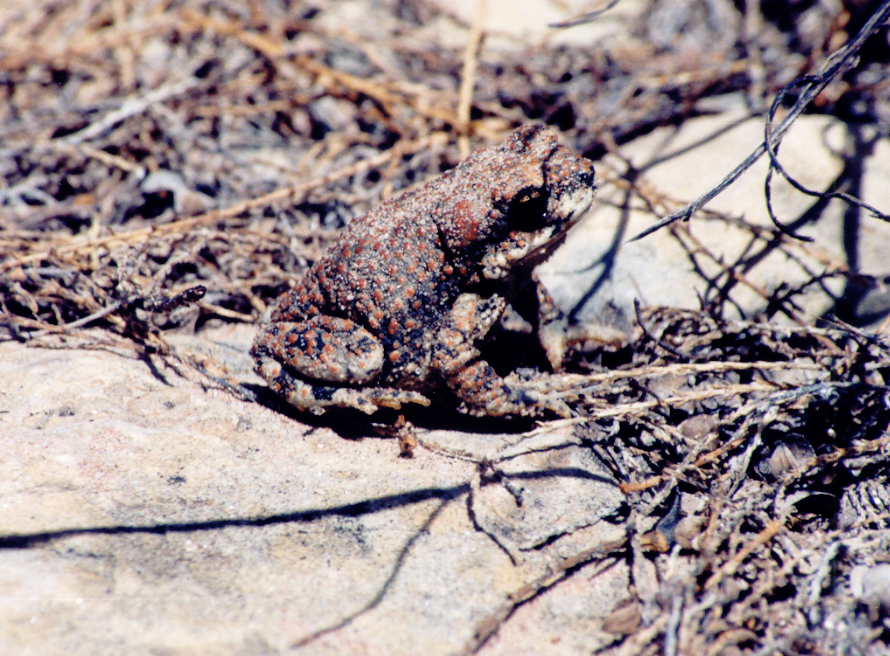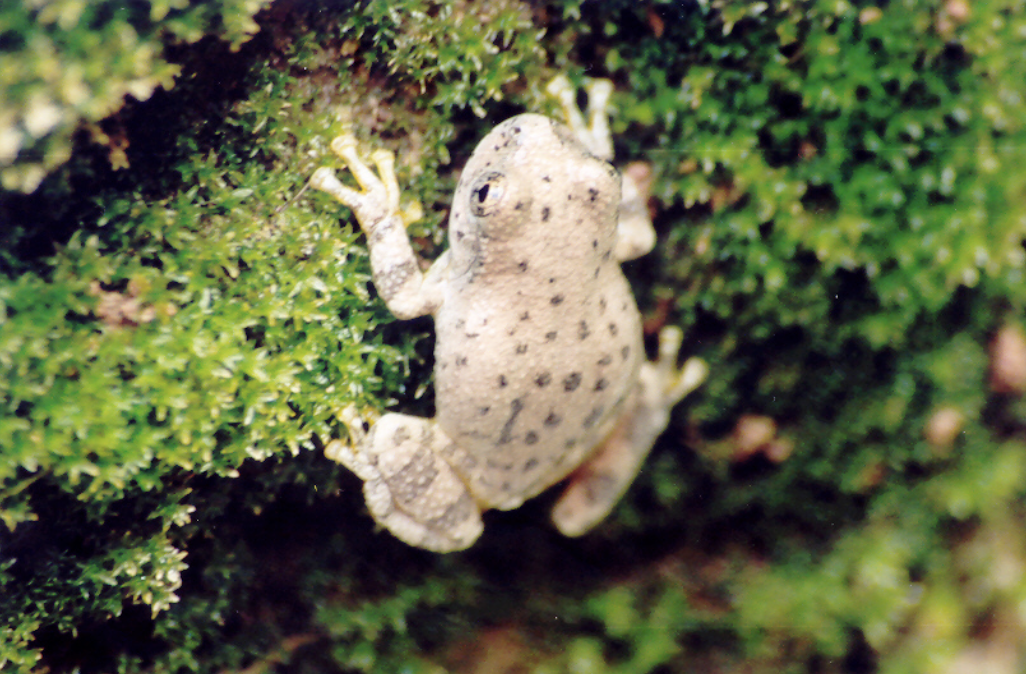There are four species of amphibians present in the Colorado River corridor of the Grand Canyon, all of which are anurans (frogs and toads) (Dettman 2005). The northern leopard frog (Rana pipiens) is only known to exist in the portions of the river just below Glen Canyon Dam. In contrast, the Woodhouse’s toad (Bufo woodhouseii) and the red- spotted toad (Bufo punctatus) are found throughout the river corridor, mainly in the riparian areas. Finally, the canyon treefrog (Hyla arenicolor) is common in the tributaries leading into the Colorado River (Miller et al. 1982). Where to find these amphibians and how to identify them are important tools for wildlife watching in the Grand Canyon. I will focus on the latter three species, since the leopard frog is rare in the canyon.

Figure 1. The Woodhouse’s toad (Bufo woodhouseii) is common in sandy areas of the Grand Canyon (Photo: www.enature.com/fieldguide).
The Woodhouse’s toad (Fig. 1) is a medium-sized toad that ranges in size from 1_ to 5 inches snout-to-vent length (SVL) (Stebbins 2003). SVL is the distance from the tip of the snout to the vent and can be most easily estimated by looking at the ventral side of the toad. Woodhouse’s toads are easily distinguished from other Grand Canyon amphibians by the white dorsal stripe that runs down their back (prominent in adults), along with their elongated parotoids (glands located behind the eyes) (Stebbins 2003). Their dorsal color is often mottled and varies from green to brown to gray.
Woodhouse’s toads can be found in a variety of habitats within the canyon, and can stray quite a distance from water. Water is really only required for breeding purposes, and this toad may use quiet parts of streams or marshes to breed in the canyon. The most useful habitat preference to consider when searching for this toad is its preference for sandy areas (Stebbins 2003). The one individual that we found during our trip through the canyon was hopping up the sandy edge of a trickling stream coming out of a Tapeats sandstone cliff at river mile 137 (otherwise known as Poncho’s Kitchen). It was in the old high water zone, and was headed away from the river. These toads are chiefly nocturnal, and this one was found around midnight. To find a Woodhouse’s toad, you should search at night in sandy portions of the riparian zone.

Figure 2. This red-spotted toad (Bufo punctatus) was found in a small, dry wash at river mile 139 (Photo: Jessica Dettman).
The red-spotted toad is considerably smaller, and ranges in size from 1_ to 3 inches SVL (Stebbins 2003). This toad is easily identified by its flat body shape, round parotoids, and reddish or orange warts on its dorsal surface (Fig. 2) (Stebbins 2003). These warts are distinct on most individuals. Background color of the dorsal surface may be light gray, olive, or reddish brown. This toad also utilizes a variety of habitats, but generally prefers the rocky portions of these habitats. Red-spotted toads are excellent climbers and are often found among rocks, which they use the crevices of for shelter (Stebbins 2003). We found one red-spotted toad individual at river mile 139. The toad was quite small (about 1 in. SVL), and was jumping around in a small, dry creek wash that led from the cliffs to the river’s edge. As I approached, the toad tried to retreat beneath rocks and vegetation that were located near the boundary of the old high water zone and new high water zone. This toad was found during midday, although nocturnal activity is more common. Rocky riparian areas seem to be the ideal place to find a red- spotted toad, with a better chance of locating one during the nighttime hours.

Figure 3. This canyon treefrog (Hyla arenicolor) was found alongside Havasu Creek (Photo: Jessica Dettman).
The third common species, the canyon treefrog, has a SVL between 1_ and 2_ inches. This is the only treefrog species in the Grand Canyon, and therefore its toepads (circular fleshy projections on the end of the toes) are diagnostic for this species. The color ranges from brown to cream to olive-gray dorsally (Stebbins 2003). This species usually stays near water, and favors streams with quiet pools and rocky bottoms (Stebbins 2003). Interestingly, Miller et al. (1982) claim that this frog is only found in the clearwater tributaries. However, we found three canyon treefrogs while in the Grand Canyon, and two of them were located in a pool beside Lava Falls Rapid (about river mile 179). This location was clearly part of the mainstem, indicating that these treefrogs may utilize the mainstem as well as the tributaries. All three frogs were spotted during the day among boulders near pools of water, indicating that daytime and streamside locations are suitable for canyon treefrog sightings (Fig. 3).
In general, the three common anuran species within the Grand Canyon have found a way to effectively divide the available habitat. Woodhouse’s toads use mostly sandy area, red-spotted toads prefer rocky areas, and canyon treefrogs favor boulders that are closely associated with water. These species are also easily distinguishable from one another, which makes them ideal subjects for the inexperienced frog watcher. So, when you visit the Grand Canyon, keep your eyes out for amphibians hopping about in the day or the night.
REFERENCES
Dettman, J.A. 2005. “Glen Canyon Dam: A mixed blessing for mammals, reptiles, and amphibians?” In. J. Mount, P. Moyle and C. Hammersmark (eds.). Ecogeomorphology of the Grand Canyon and its Tributary Streams. Davis, CA. http://watershed.ucdavis.edu/grand_canyon/history.html.
Miller, D. M., R. A. Young, T. W. Gatlin, and J. A. Richardson. 1982. Amphibians and Reptiles of the Grand Canyon National Park. Grand Canyon Natural History Association Monograph Number 4.
Stebbins, R. C. 2003. Western Reptiles and Amphibians, Peterson Field Guide. Houghton Mifflin Company, Boston, New York, USA.
